#seljuk dynasty
Text
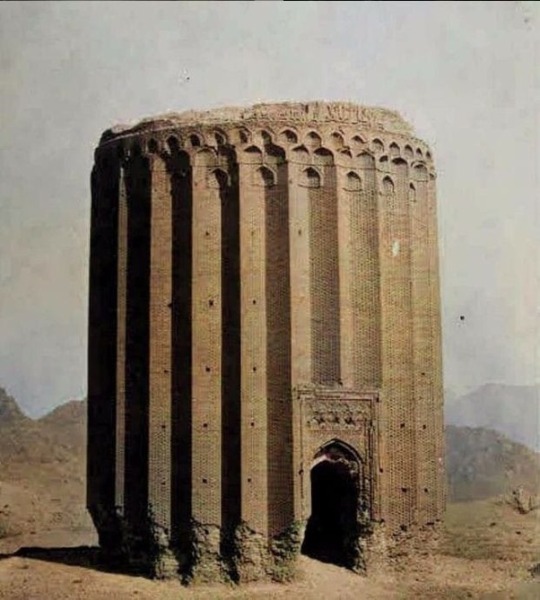
the Toghrol Tower in Rey, Iran (1063),
A Building to tell the time...
The Toghrol Tower is a 20 meters high tower located in the city of Rey in Iran made of bricks and Sarooj, a water-resistant mortar.
It was erected in 1063, and according to some sources, it was conceived as the tomb of Tuğrul Beg, the founder of the Seljuk dynasty.
Other scholars report that it was used as a lighthouse to guide the travellers of the Silk Road during foggy days and nights.
#art#history#design#archeology#style#tower#iran#toghrol tower#rey#architecture#vintage photography#bricks#sarooj#mortar#tomb#seljuk dynasty
524 notes
·
View notes
Text
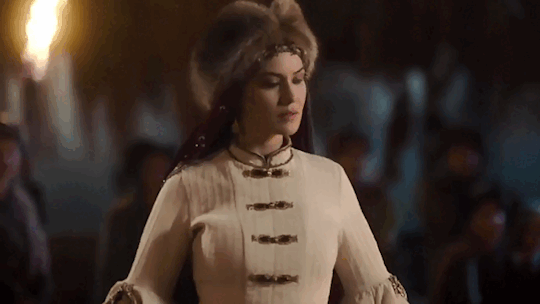














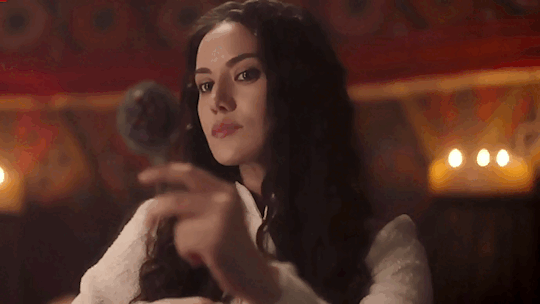



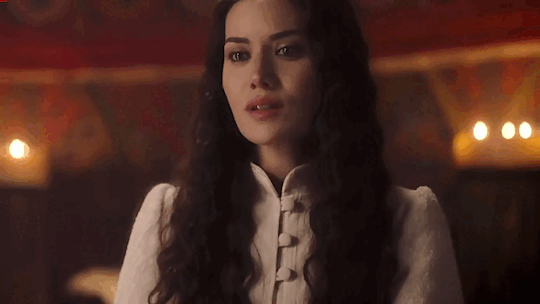









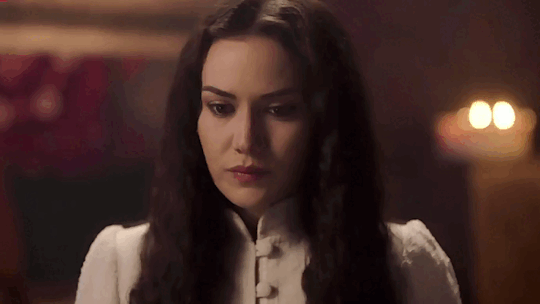
Here is a #510 gifs of Fahriye Evcen in The Great Seljuks. All of these gifs were made by me from scratch, so do not redistribute or claim them as your own. If using, please give this a like and reblog!
#gifshistorical#seljuk dynasty#the great seljuks#perioddrama#fahriye evcen#fahriye evcen gif#fahriye evcen gif pack
15 notes
·
View notes
Photo

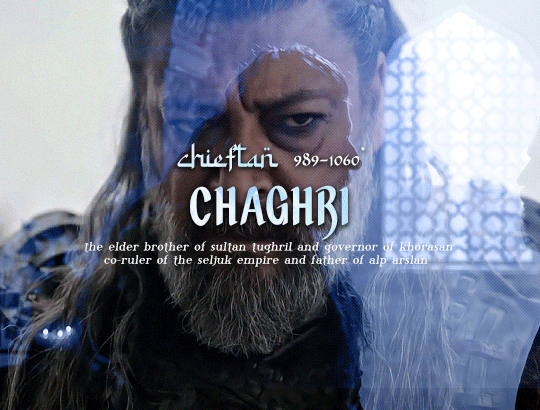


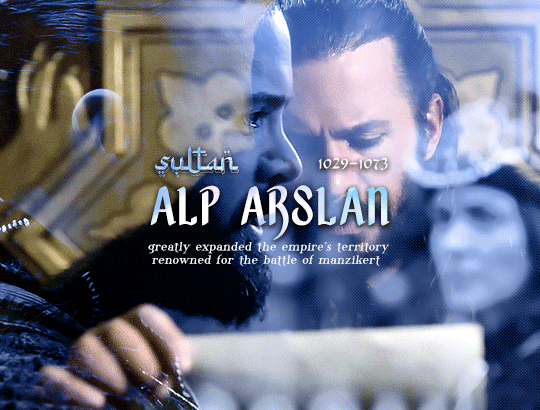

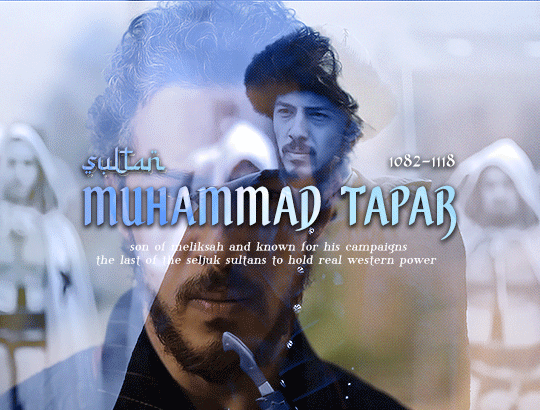

the dynasty played a crucial role in forming a barrier to europe against the mongol invaders of the east — while also defending the golden islamic world from the crusaders of the west. renowned for their schools and love of great architecture, the seljuks created a united empire within central asia and the middle east that shaped the fate of the eurasian continent for centuries to come.
— NOTABLE MEMBERS OF THE SELJUK DYNASTY
#historyedit#perioddramaedit#usergif#gifshistorical#seljuk dynasty#the great seljuks#ceremonial#usermare#usersha#useraashna#userdre#userfrodosam#usercharithra#southfarthing#usermina#user-oomh#turkishdizis#ccnet#cinematv#creations#userjoanna
127 notes
·
View notes
Text
byzantine emperor alexios I komnenos: greetings my good personal friend pope urban ii pls help a fellow brother in christ against the seljuk dynasty 🙏 im specifically asking u for military aid for the sole purpose of repelling the encroaching enemy force and ejecting them from my domain 🙏 nothing more nothing less I have this one specific concrete plea
pope urban ii: yeah no u got it absolutely im here for u im here to hear so to speak im all over this I got u and the message fr
pope urban ii at clermont 1095: lads LADS listen my good personal friend byzantine emperor alexios I komnenos wants us to *looks at smudged writing on hand* go ape shit and reconquer the holy land!!!!!!!!!!!!!!! everyone who goes gets fast tracked to heaven and all ur sins are forgiven and if u scan this qr code u can print out a cross and put it on ur cloak to get 15% off the first cup of wine once we reach konstantinopel lets ball!
byzantine emperor alexios I komnenos:

95 notes
·
View notes
Text

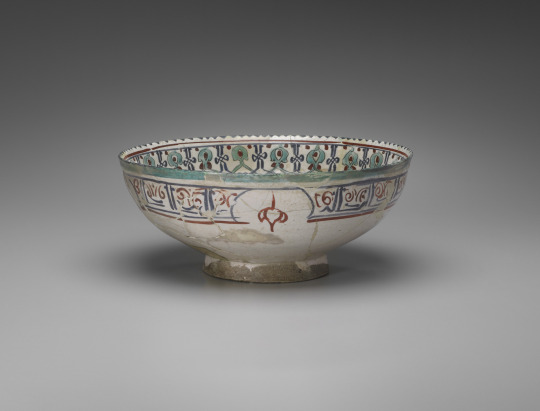
~Bowl depicting Faridun, Kava, and Zahhak in an episode from Firdawsi’s Shahnameh.
Date: late 12th–early 13th century
Culture: Persian, Iranian, Islamic, probably Kashan
Period: Seljuk dynasty (1038–1194)
Medium: Mina'i ware; fritware with polychrome enamel on an opaque white glaze.
#12th century#13th century#pottery#bowl#faridun#kava#zahhak#Firdawsi's Shahnameh#persian#iranian#islamic#kashan#sejuk Dynasty#mina'i ware#history
342 notes
·
View notes
Note
Which Byzantine figures do you consider underrated? As someone who has slowly started to learn more about Byzantium, names like Constantine the Great, Justinian the Great, Theodora, Irene of Athens, Anne Komnene, Nikephoros Phokas, Constantine Palaiologos, Tsimiski, Basil, Zoe and Theodora Porprhyrogennita and Theophano are familiar, but do you have any other recommendations (sorry if I misspelled some)?
Below are a few Byzantine historical figures I find very interesting currently:

Flavius Belisarius (c.500 - 565)
While Justinian the Great is one of the most significant emperors in history, his accomplishments would simply not be the same, if he did not have Belisarius as his military commander. He was of uncertain descent (possibly Thracian, Illyrian or less so Greek) but his mother tongue was certainly Latin. Belisarius reconquered Rome and Italy while severely outnumbered during the Gothic War, defeated the Sassanids in the Iberian War, conquered the Vandal Kingdom in North Africa, successfully repulsed the Huns and defended the empire from the Persians and the Arabs. The Byzantine Empire reached its largest surface mostly thanks to Belisarius. A more controversial point in his life was when he was commanded to suppress the notorious Nika riots against Justinian, which ended in a massacre of dozens of thousands civillians. Belisarius was above all a strategist; he didn't mind fleeing the battle or using trickery in order to win a war. Despite his analytical mind in battle, he resolutely wasn't one in the affairs of the palace. Belisarius was married and quite smitten with Antonina, who had the favour of Empress Theodora, and thus felt safe to be totally unhinged. Schemes happening in the palace would sometimes find a scapegoat in Belisarius, who was likely the most genuinely devoted person to the emperor. As a result, Belisarius was often not treated well by the emperor and the secretaries and he was cheated on by his wife. He was even led to trial for betrayal, although Justinian eventually pardoned him. According to legend, Justinian first blinded him and then pardoned him, although lately the historicity of this is questioned. What's certain is that Belisarius didn't receive the respect he deserved in his personal life but he earned the respect of the historians, who consider him one of the best military leaders in history.
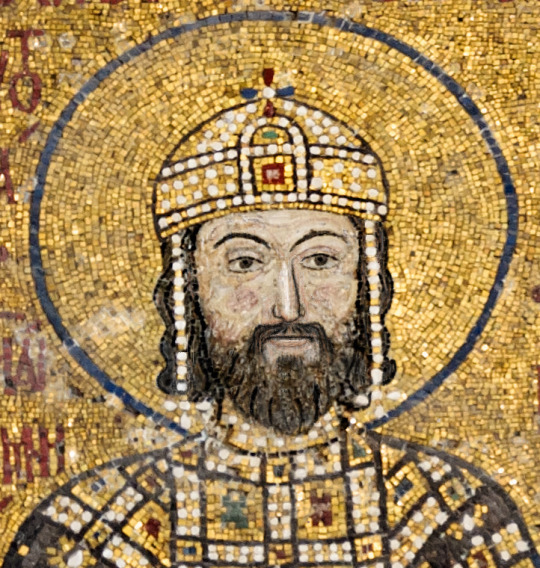
Ioannis II Komnenos (1087 - 1143)
Known as Kaloioannis (John the Good / Beautiful), Ioannis is considered the best emperor from the Greek dynasty of the Komneni. Ioannis was not beautiful, he must have been rather unattractive actually, but he earned the title because of his noble character. He was the brother of Anna Komnene, he was the one she tried to poison so that she would ascend to the throne instead. Ioannis forgave her. Ioannis was very just, modest and pious and would only use his imperial luxuries during diplomat visits. He was married to Irene of Hungary. Whether it was because of his piety, his natural predesposition or a different orientation, Ioannis was not very interested in the joys of marriage. However, he remained devoted and faithful to her. It is notable that during his long reign, not a single person was sentenced to death or mutilation, at a time that this would have been the norm for criminals and traitors. Despite all that, Ioannis was actually a great military leader once need arose. His biggest goal as an emperor was to undo the damage from the Battle of Manzikert 50 years prior. Indeed he forced Seljuk Turks to assume a defensive stance and did expand the empire's power to the east again. The Byzantine population increased during his reign. It is certain that Ioannis left the empire significantly better than how he received it. Some sources suggest that Ioannis' noble character was an inspiration to the people of his empire.

Michael Psellos (1017 - 1078)
Psellos was a Greek man of great knowledge and intellect and a questionable character. He did it all; he was a monk, a writer, a philosopher, a judge, a music theorist, an imperial advisor and courtier and a historian. His skill in literally everything led him quickly to the position of the leading professor in the University of Constantinople and that of secretary in the imperial court. His political influence was immense and he saw many emperors succeed each other while he maintained his position as political advisor. Because a big part of his work is autobiographical, it is unclear whether some of his claims are entirely reliable; Psellos was prone to vanity and sarcasm against those who did not favour him. Psellos studied Plato thoroughly, so much so that at times his faith in Christian Orthodoxy was questioned. *Fun fact: Psellos was apparently good at everything except Latin. His Latin was so rusty he confused Cicero with Caesar!
He looks like a Greek Rasputin in his painting above lol Anyway, he was manipulative but he wasn't nowhere near as controversial as Rasputin, let me be clear.
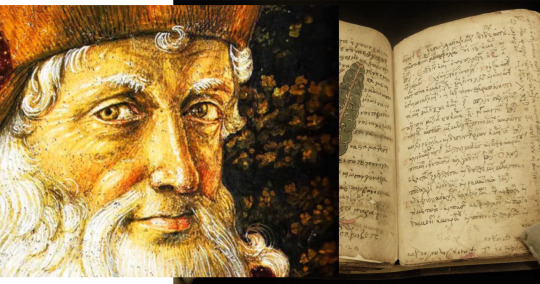
Georgios Gemistos Plethon (c. 1355 - 1452/1454)
Gemistos Plethon was a scholar and philosopher of the late Byzantine era. He was the pioneer of the revival of Greek scholarship in Western Europe. He was secretly not Christian, he believed in the Ancient Greek gods. Plethon admired Platon too. (It's Platon in Greek.) So much so that he added "Plethon" next to his surname Gemistos, which means pretty much the same thing (full) except more archaic and more similar to Plato(n)'s name! He was imperial advisor to the Palaeologi dynasty who at the time were reigning from Mystras, as the empire was dissolving. Everyone suspected his pagan beliefs but he was so influential and important that nobody dared confront him about it. He taught philosophy, astronomy, history, geography and classical literature. He was invited to Florence, Italy to teach Plato and Aristotle and help Florentines understand the differences between the two philosophies. Plethon died in Mystras shortly before or after the Fall of Constantinople. We don't know if he lived enough to see the empire fall. Around 10 years later, some of his Italian followers stole his remains from Mystras and interred him in Rimini, Northern Italy, so that he could "rest amongst free men". Plethon's vision was the revival of the Byzantine Empire, founded on a utopian Hellenic (and not universal) system of government. In one of his speeches, he said "We are Hellenes by race and culture". He is at the forefront of historical studies exploring the connections between Byzantine and Modern Greek identity.

Laonikos Chalkokondyles (c. 1430 - 1470)
Chalkokondyles was an Athenian native, from a prominent old family of the city. He was a historian who witnessed the last years of the Byzantine and the early years of the Ottoman Empire. He was sometimes employed by the Byzantine emperors as a messenger to the Sultan Mehmed II, not without drama. Chalkokondyles wrote in detail about 150 years prior to his lifetime. He described the fall of the Byzantine Empire, he offered a profile of the Ottoman Turks, and he wrote about their conquest of the Venetians and Matthias the King of Hungary. He also explored the civilisations of England, France and Germany. I didn't know about him until I read a great Romanian biography of Vlad Tepes the Impaler (you know, the inspiration of Count Dracula). Chalkokondyles's input is extensive and invaluable for this book; he wrote about Vlad's ancestors and the fights of the Wallachian princes with the Ottomans. His style of writing was mostly clear and simple, styled after Thucydides. He called the Byzantines “Hellenes” and did not use the term "Rhomaioi" (Romans in Greek) for them.
#byzantine empire#eastern roman empire#history#medieval history#middle ages#byzantine history#greek history#greeks#greek people#attichoney4u#ask#long post#tw long#long text#tw long text#tw long post
44 notes
·
View notes
Text
Hi everyone,
In honor of my TOG fic “Their souls were knit together (and he loved him as himself)” reaching 10k (thank you readers!!) I wanted to compile my (80+) resource links I used during the plotting stage and throughout the fic - divided by category as best as I could manage.
In case you’d like additional resources, please check out @actualmermaid historical resource upload here, and/or the The Old Guard Character Resource Hub. Here’s a list of books as well:
Genoa & the Genoese 958-1528 ( x )
The Crusade Indulgence: Spiritual Rewards and the Theology of the Crusades, c. 1095-1216 ( x ) - a post with excerpts linked below
Housing the Stranger in the Mediterranean World: Lodging, Trade, and Travel in Late Antiquity and the Middle Ages ( x )
The rest under the cut in case you’d like to avoid potential spoilers (nothing descriptive)
For Genoa
San Siro ( x )
San Lorenzo ( x ) & St. John the Baptist ( x )
The Mahdia Campaign of 1087 ( x )
Nicolò as a Genovese crossbowman ( x ) ( x )
For Mahdia
Yusuf’s potential backstory with Mahdia ( x ) ( x ) and the Zirid dynasty ( x )
And his family’s intergenerational trauma in relation to the Battle of Haydaran in 1052 ( x )
For the Crusades
Some other ways a non noble Nicolò might have found himself in the Crusades ( x ) ( x ) ( x )
General timeline of the first crusade ( x )
The Siege of Antioch ( x ) ( x ) ( x ) ( x ) ( x )
The Siege of Jerusalem ( x ) ( x ) ( x ) ( x )
Visual maps of the city of Jerusalem and surrounding area ( x ) and general climate ( x )
For Constantinople
Daily life in the city ( x ) ( x ) ( x )
Procession of the Theotokos icon ( x )
Maps of the city from that time ( x ) ( x )
Their apartment and general housing ( x )
Little Hagia Sophia ( x )
Church of Sts Sergius and Bacchus ( x ) - and why that would have been meaningful to Nicolò ( x ) as the setting for their Adelphopoiesis ( x ) & here are the Byzantine instructions for it ( x )
For Islamic spiritual practices
Barzakh ( x ) & Jinn ( x ) (both referred to in a blink and you’d miss it sort of way)
Qur’an scroll ( x ) - technically a 19th century copy, but was using it as a visual reference
Islamic calendar for that year ( x ) & the significance of Yusuf’s first death of rajab ( x )
The verse Yusuf reflects on when he internally refers to Nicolò as his dearest ( x )
The verse Nicolò inscribed on Yusuf’s wedding present ( x )
For Catholic spiritual practices
Lay Orders (what used to be called Third Order) for Nicolò to be an oblate ( x )
Eleusa icon (a gift he received from Brother Gabriel) ( x ) - here’s a 12th century version ( x )
The cross necklace gift Nicolò received before leaving Genoa ( x )
Excerpts from the book linked above about how indulgences played a part in the Crusades ( x )
Lenten practices in the middle ages ( x )
Some Bible verses Nicolò reflects on during his love confession ( x ) ( x )
For some interfaith dialogue moments
The Canticle of Zechariah in the Liturgy of Hours ( x ) & Verse 95 for corresponding references to the dawn ( x )
Why Zechariah is important in both faiths ( x )
Encouragement for open dialogue and friendliness ( x ) the rights of Non-Muslims as laid out in the Constitution of Medina ( x ) and protection via the Testament of Muhammed ( x ) though there are some doubts to the authenticity
Lent & Ramadan similarities ( x ) ( x )
Interfaith marriage rights between Christians and Muslims from Muhammed ( x )
For some other historical context
Context for same sex attraction in the middle ages ( x ) ( x ) ( x ) ( x ) ( x ) ( x )
Some LGTB+ historical figures and Saints Nicolò might have been aware of ( x ) ( x )
Brother Gabriel from chapter two was based on Marina the Monk ( x )
Wiki about illiterate popes ( x )
11th-12th century trade maps ( x )
Tunisian Arabic ( x )
The Great Schism of 1054 ( x )
The Seljuk Empire ( x )
The Byzantine-Venetian treaty of 1082 ( x )
A poem by Abu Nawas that Yusuf reflects on before the love confession ( x )
For the Biblical references and significance to Nicolò of Gortyn/Crete ( x ) and some visual references ( x )
Why Chandax as a honeymoon site would have been comfortable for them both ( x ) & ruled by the Byzantine Empire at the time of their visit ( x )
The book Yusuf gave to Nicolò as a wedding present ( x ) & some context ( x )
#thank you readers!#their souls were knit together fic#tog fic#tog#the old guard#the old guard fic#tog resource#the old guard resource#immortal husbands#joe x nicky#yusuf x nicolo#tog joe#tog nicky#yusuf al kaysani#nicolò di genova#for queue
49 notes
·
View notes
Text
تركيا Iğdır Caravanserai أو Ejder Caravanserai هو Caravanserai من سلالة السلاجقة يقع في حي Kervansaray بقرية Harmandöven في Iğdır. تقع على الجانب الغربي من منطقة كرفان سراي ، على بعد 31 كم جنوب إيجدير ، وقد تم بناؤها في عهد شرف الدين إجدير ، أمير سورملي (في 1300-1400).





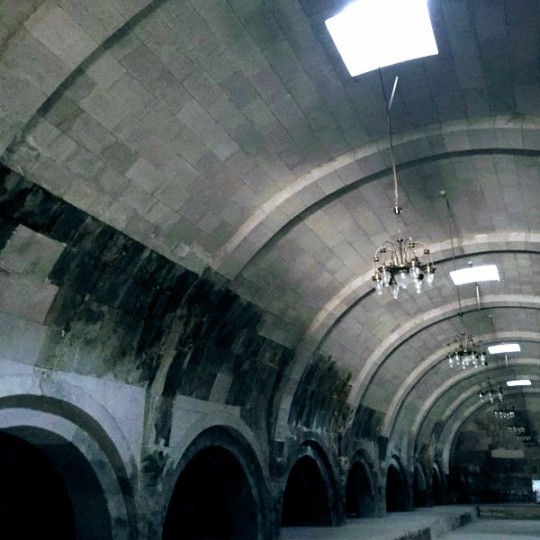
Türkiye,Iğdır Caravanserai or Ejder Caravanserai is a Caravanserai from the Seljuk Dynasty located in the Kervansaray neighborhood of the Harmandöven Village of Iğdır. It is located on the west side of Kervansaray district, 31 km south of Iğdır. It was built during the time of Şerafeddin Ejder, Emir of Surmeli (in the 1300-1400's).
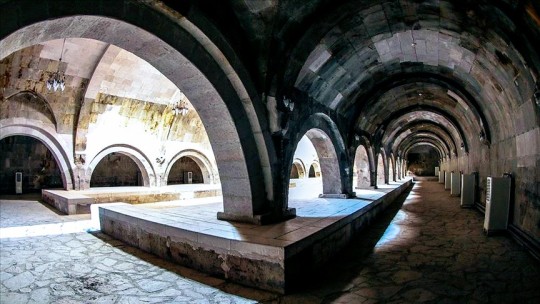

Iğdır Kervansarayı ya da Ejder Kervansarayı, Iğdır'ın Harmandöven Köyüne bağlı Kervansaray mahallesinde bulunan Selçuklu Hanedanından kalma bir Kervansaraydır. Iğdır'ın 31 km güneyinde, Kervansaray mahallesinin batı tarafında bulunmaktadır.Sürmeli Emiri Şerafeddin Ejder zamanında (1300-1400'lü yıllarda) yaptırılmıştır.
#Iğdır Kervansarayı#Iğdır Caravanserai#تركيا#türkiye#travel photography#view#travel destinations#travel#Türkiye#ığdır#tarihiyer#turistikyer#asia#Anadolu Selçuklu#Selçuklu devleti
88 notes
·
View notes
Text
A Building to Tell the Time: The Toghrol Tower in Rey, Iran (1063)

The Toghrol Tower is a 20 meters high tower located in the city of Rey in Iran made of bricks and Sarooj, a water-resistant mortar. It was erected in 1063, and according to some sources, it was conceived as the tomb of Tuğrul Beg, the founder of the Seljuk dynasty. Other scholars report that it was used as a lighthouse to guide the travellers of the Silk Road during foggy days and nights.
The tower has a deep wall and a peculiar geometry: its internal surface is a smooth cylinder of 11m in diameter, while the external shape is a polygon of 24 angles, whose vertex compose a circle of 16m in diameter.
Keep reading on SOCKS:
41 notes
·
View notes
Note
About sadik: thats what i was wondering!! Bc the Turkish population now look vastly different from centuries ago because of mixed ethnicity families, so what would Turkey be? Because if he's a nation that existed for a long time, would he look like how the population looks now because a country represents their people? Or would he look like how the they did before?
This is also why i feel slightly irritated about the "Turkey was whitewashed" thing, because I've seen so many Turkish people and made friends with them before, and some can have pale skin and green eyes, some can be darker with brown eyes. You can't really whitewash a country that has such a diverse population.
Then again that's just my opinion based on experience, i hope i wasnt rambling
That's the thing! like how old is Sadik supposed to be? is he the Seljuk Turks as well, because the Seljuks were fighting the Byzantines way before the Ottoman dynasty popped up, and being a Seljuk Turk would very very likely make him Oghuz.
Gonna swing a bat at a hornets' nest here but the 'Turkey was whitewashed' is right up there with 'Spain was whitewashed' nonsense. like first, there's a difference between ethnicity and race and frankly you (not you specifically, just general you) can't apply race outside a Western context, so this argument is already stupid. like just be honest and say he doesn't look how you think a Muslim ought to look because that's the basis people judge 'white' vs non-white on, and you can tell because Greeks and Anatolians are the same ethnicity but generally the Greeks are considered white while the Turks aren't. like we can talk about the Armenians and Azerbaijani the same way. people just really want religion to line up nicely with ethnicity and it doesn't.
#itstokkii#getting my bat ready in case there are turkish nationalists on tumblr#like I'll fight you too if I have to ig
5 notes
·
View notes
Text
Hot Airing over Antiquity
Despite our chances of soaring over the Cappadocia region in hot-air balloons being dashed by the poor weather, we still had one last opportunity in Pamukkale. It might not have caverns and deep gullies, but it was still impressive to hover over the ‘Cotton Castle’ in all its limestone glory. And also take in the ancient city of Hierapolis via air.
Nothing screams adventure more than looking upon an ancient amphitheatre from above. Or, you know, running the risk of dropping your phone and losing all evidence of your overseas trip. But, I hear you, dear reader, say, it’s all about the experience, right?
Wrong! Here in the internet age, if there are no pictures, it’s doubtful it even happened. And even WITH photographic proof, editing software makes it easy to question EVERYTHING. Coupled with the fact that I hate taking pictures of myself? Why, it could be easily claimed that I stole all my photos from Google.
I didn’t, of course (what kind of travel blogger would do that), but it’s something easy that detractors can claim. Not that I have any detractors. My little corner on the internet is rarely frequented and when it is, it’s mostly by people I already know in real life. Which is exactly how I like it!


Regardless, the trip up in the air was quite smooth. We were up in the air and I didn’t even feel a thing. Best of all, we didn’t crash land. Nor did we become a ball of flame that hurtled to the ground in a fiery explosion. I might not have liked being bombarded by fossil fuel natural gas every time the pilot fired up...well, the fire...but I am thankful for getting an opportunity to take to the skies and look down at all the unworthy ants crawling down beneath me.
Delusions of grandeur, thy name is Kyndaris!
Once we landed, we packed hurriedly into the minivan and headed straight back to our hotel. And it was here that I bid a silent farewell to my Malaysian ballooning companions. I might not have gotten any of their names but I did overhear most of their conversations as they called family and friends while riding up in the balloon. And while I was very tempted to make my known in at least half of their calls, I resisted the urge.
So kind of me! So magnanimous!
All right. I think that’s enough self-aggrandising from me. Back to detailing my actual exploits while on holiday.
After returning to hotel, I went back to the room that I shared with Popo and readied to luggage to bring down to the coach. Then it as off to actually explore Hierapolis by foot. Or, more technically, as a chauffeur for Popo and her friend as I drove around on a modified moped.
The name, Hierapolis, is Greek in nature and according to the information board that I took at the site, means ‘Sacred City.’ It was presumably founded by one of the successors of Alexander the Great. In 188BC, it was passed into the hands of the Kings of Pergamon before becoming one of the wealthiest cities during Roman times. At the sight, there was plenty to see including a ruined temple of Apollo and a statue dedicated to Pluto, or Hades. I only recognised him because of the three-headed guardian to the Underworld, Cerberus, that stood at his side.
The city also featured many iconic Roman buildings including baths, gymnasium and theatre. I certainly knew that my 17-18 year old self would have been leaping for joy if I’d visited then, giving my interest in Ancient History and, in particular, the Flavian period of the Emperors.
Young children might be able to tell me in excruciating detail about their favourite dinosaurs. I will respond with my own rant upon my supposed subject of expertise - the Julio-Claudian emperors and the Flavian dynasty, which followed after Nero and the Year of Four Emperors.
History aside, it ought to be known that despite being the Sacred City of antiquity, Hierapolis was abandoned following an earthquake in about 616 AD that left only a few crumbling buildings in its aftermath. Despite this, there are signs of Seljuk presence in the ruins. Which would indicate that people had still frequented the site up until 400 years after the devastating quake.
But because of that, the city was almost pastoral in appearance with swaths of green covering the ruins. What made Hierapolis so special for us, though, was the ‘Cotton Castle’ that the city was built atop on. Layered all in white, the city was favoured with warm thermal waters that bubbled to the surface and which were rich in minerals. Over the years, it had covered the cliff tops in a layer of white limestone. And even in this modern age, those thermal waters continue to gurgle, which Popo got to enjoy by dipping her toes in.
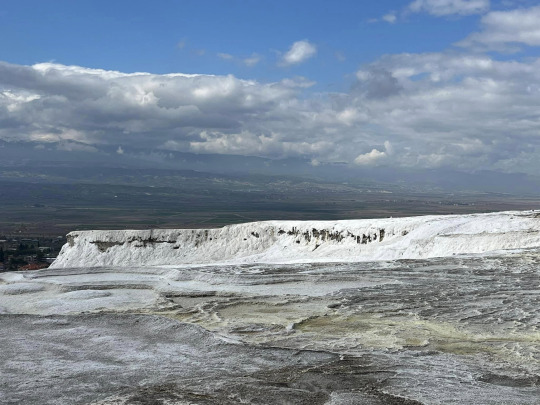
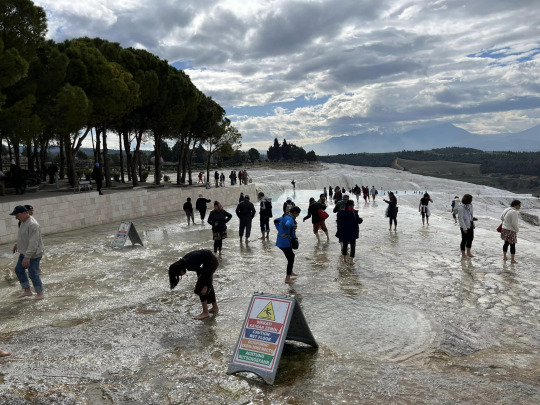
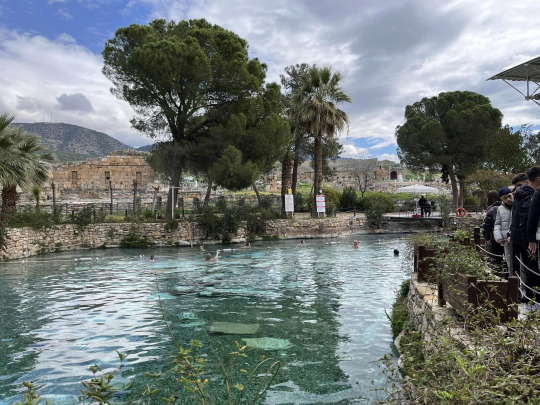
There was also a swimming pool with sunken columns at the city that visitors could pay to enter.
Talk about taking advantage of what mother nature has given you! I however, simply enjoyed admiring the scenes of Europeans floating in the warm waters before inspecting the adjacent museum where displays of old pottery and statues could be seen. There were even carved reliefs depicting the coronation of Septimius Severus, a Roman Emperor, by the Goddess Nike and one that saw Dionysus, the Greek God of Wine and Debaurchery, partying hard with nymphs, centaurs, satyrs, the cherubic Eros and Pan.
After drinking in our fill of the city, we had a quick lunch in what felt like a communal cafeteria that stunk of oil before heading back on the road. This time we were headed westward to the Aegean Sea! Kusadasi, here we come!


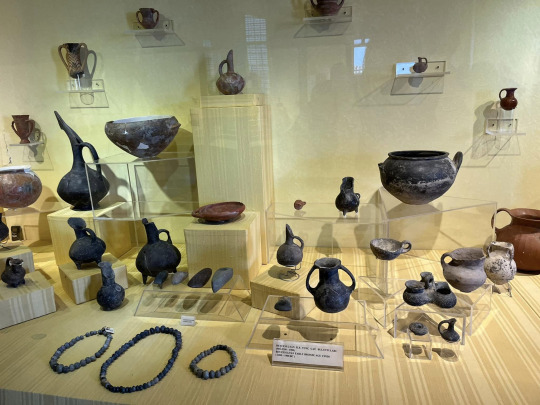

2 notes
·
View notes
Note
👑 and ⌛for the WIP asks!
Thanks! :D I'll do this for Like Snow on Hungry Graves:
👑 - Are there rulers? A government? Who calls all the shots?: Yep! There are three main kingdoms: Vakaryan, Sui (based on Tang-dynasty China) and Çarisar (based on the Ottoman Empire, with elements of the Seljuk and Mongol Empires). So far only Vakaryan has got much attention, and I haven't figured out how the other kingdoms work.
Vakaryan (Rusudan's home): Is ruled by Queen Khvareshan. Her oldest child and heir is Princess Ketevan, which means the kingdom is basically doomed as soon as Ketevan takes over. But Rusudan is more-or-less ruling behind the scenes because she has information on everyone, is extorting money from everyone, and can influence government decisions if she wants to. She also hates Ketevan, so there's a decent chance she'll stage a coup and make herself queen as soon as Khvareshan dies.
Sui: Is ruled by an emperor. Who happens to be Konstantine's father, and is also the worst. Seriously, he sets his own son up for murder.
Çarisar: Is ruled by an emperor, who happens to be Hariye's grandfather.
⌛ - What time period does it take place in? Does it combine periods?: It's set in a fantasy world loosely inspired by several different time period. Sui is based on Tang-dynasty China (618–907), Vakaryan is based on 13th-century Georgia, and Çarisar is based on a mixture of the Mongol Empire (1206–1294*), Seljuk Empire (1037-1194) and Ottoman Empire (1299–1922**).
*disputed; if you consider the Yuan dynasty a continuation of the Mongol Empire, then it didn't fall until 1368. And if you count the Northern Yuan dynasty, then it didn't fall until 1635.
**no, that's not a typo. The Ottoman empire really did last that long.
2 notes
·
View notes
Text
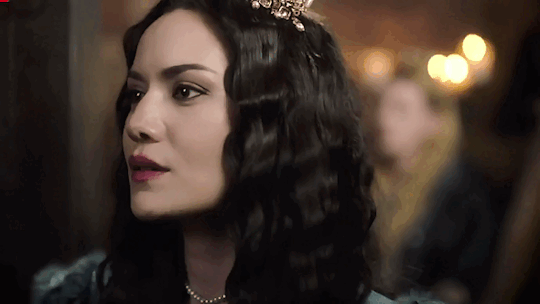














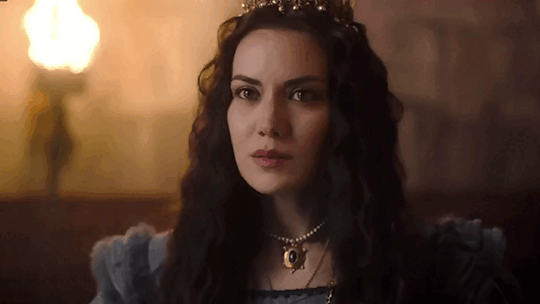


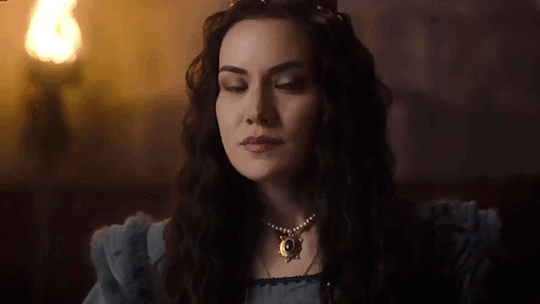







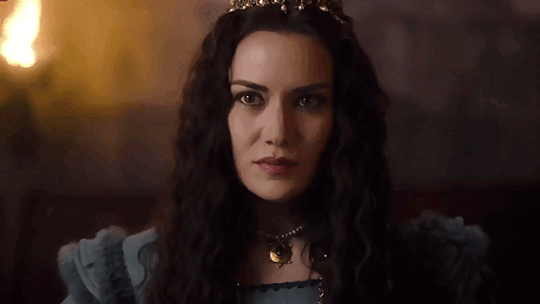



Here is a #510 gifs of Fahriye Evcen in The Great Seljuks. All of these gifs were made by me from scratch, so do not redistribute or claim them as your own. If using, please give this a like and reblog!
#gifshistorical#seljuk dynasty#the great seljuks#perioddrama#fahriye evcen#fahriye evcen gif#fahriye evcen gif pack
7 notes
·
View notes
Note
happy birthday zaynab 🎉 i don’t think we’ve directly interacted before, but i absolutely adore your content a ton (especially the pretty overlapped gifs + text sets, like the seljuk dynasty one; jaw-dropping, really!) & you best believe that every single time i have seen you reblog my stuff, i am reminded that user jeonwonwoo—one of the best gif makers here—liked my content enough to reblog it and leave nice tags too :’) hope you have the most wonderful of days ever, surrounded by good things and good people ♡ happy birthday again!
this is soooo cute im literally giggling so much abt this im gonna think abt it all day!!!!!! thanku so much for the sweet message it means a lot and im so glad u like my gifs 😭 (esp the seljuk one bc that is so dear to me)
2 notes
·
View notes
Photo
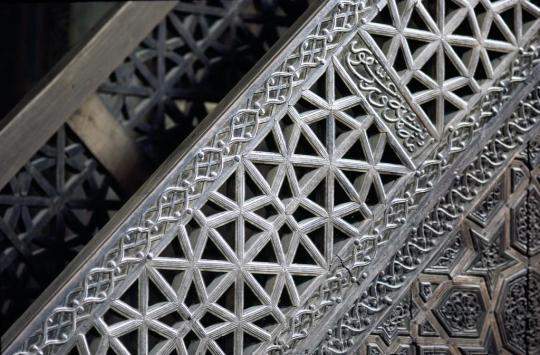


Minbar, Arslanhane Mosque, Ankara, Turkey, ca. 1289-90, Seljuk dynasty, wood carving.
6 notes
·
View notes
Text
Usman dan Fodio is a fairly typical kind of figure in Islamic history:
It should be noted further on those same lines that Usman dan Fodio is a very typical figure in Islamic history. The self-proclaimed reformer renewing the state against the loathsome semi-godless hedonists of the settled cities with all the wealth, proclaiming himself the renewer and restorer of the Ummah. He builds an army from a group of otherwise-divided tribal structures, creating states more or less ex nihilo, and proving a highly efficient warlord, if somewhat limited in any other factor of state-building. This pattern of states ex nihilo sees the newly empowered army smash and butcher and burn everything in its path, creating a new domain and a new dynasty atop the legacy of older ones.
This, in so many words, is the history of how the Sokoto Caliphate was formed, and its mirrors are legion, including ISIS in modern times, Tamerlane in Central Asia, Shah Ismail I and his equivalents in the Ottoman Empire's earliest days, Malik-Shah and Alp Arslan of the Seljuk Sulanate, and so on.
#lightdancer comments on history#black history month#african history#military history#islamic history#usman dan fodio#sokoto caliphate
0 notes